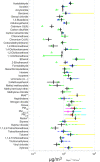Harm from Residential Indoor Air Contaminants
- PMID: 38150532
- PMCID: PMC10785761
- DOI: 10.1021/acs.est.3c07374
Harm from Residential Indoor Air Contaminants
Abstract
This study presents a health-centered approach to quantify and compare the chronic harm caused by indoor air contaminants using disability-adjusted life-year (DALY). The aim is to understand the chronic harm caused by airborne contaminants in dwellings and identify the most harmful. Epidemiological and toxicological evidence of population morbidity and mortality is used to determine harm intensities, a metric of chronic harm per unit of contaminant concentration. Uncertainty is evaluated in the concentrations of 45 indoor air contaminants commonly found in dwellings. Chronic harm is estimated from the harm intensities and the concentrations. The most harmful contaminants in dwellings are PM2.5, PM10-2.5, NO2, formaldehyde, radon, and O3, accounting for over 99% of total median harm of 2200 DALYs/105 person/year. The chronic harm caused by all airborne contaminants in dwellings accounts for 7% of the total global burden from all diseases.
Keywords: DALY; acceptable indoor air quality; dwelling; harm budget; harm intensity; ranking.
Conflict of interest statement
The authors declare the following competing financial interest(s): Morantes is supported by a University of Nottingham Faculty of Engineering Research Excellence Scholarship to do this work. Jones received funding from the Chartered Institution of Building Services Engineers (CIBSE) and EPSRC Grant EP/T014792/1 to do this work. Constanza Molina received funding from Agencia Nacional de Investigacion y Desarrollo (ANID) of Chile, through the project ANID FONDECYT Iniciacion 11220965. Non-financial interests: Jones, Molina, and Sherman are unpaid members of the ASHRAE 62.2 indoor air quality working group.
Figures




Similar articles
-
A method to estimate the chronic health impact of air pollutants in U.S. residences.Environ Health Perspect. 2012 Feb;120(2):216-22. doi: 10.1289/ehp.1104035. Epub 2011 Nov 17. Environ Health Perspect. 2012. PMID: 22094717 Free PMC article.
-
Indoor pollutant exposure among children with and without asthma in Porto, Portugal, during the cold season.Environ Sci Pollut Res Int. 2016 Oct;23(20):20539-20552. doi: 10.1007/s11356-016-7269-x. Epub 2016 Jul 27. Environ Sci Pollut Res Int. 2016. PMID: 27464657
-
Evaluating heterogeneity in indoor and outdoor air pollution using land-use regression and constrained factor analysis.Res Rep Health Eff Inst. 2010 Dec;(152):5-80; discussion 81-91. Res Rep Health Eff Inst. 2010. PMID: 21409949
-
The burden of disease attributable to indoor air pollutants in China from 2000 to 2017.Lancet Planet Health. 2023 Nov;7(11):e900-e911. doi: 10.1016/S2542-5196(23)00215-2. Lancet Planet Health. 2023. PMID: 37940210
-
Indoor Exposure to Selected Air Pollutants in the Home Environment: A Systematic Review.Int J Environ Res Public Health. 2020 Dec 2;17(23):8972. doi: 10.3390/ijerph17238972. Int J Environ Res Public Health. 2020. PMID: 33276576 Free PMC article.
References
-
- WHO . WHO Global Air Quality Guidelines: Particulate Matter (PM2. 5 and PM10), Ozone, Nitrogen Dioxide, Sulfur Dioxide and Carbon Monoxide; World Health Organization, 2021. - PubMed
-
- HEI, IHME . State of Global Air 2020: A Global Report Card on Air Pollution Exposures and Their Impacts on Human Health; Institute for Health Metrics and Evaluation, and Health Effects Institute, 2020. available at: https://www.stateofglobalair.org (accessed 10 10, 2022).
-
- Klepeis N. E.; Nelson W. C.; Ott W. R.; Robinson J. P.; Tsang A. M.; Switzer P.; Behar J. V.; Hern S. C.; Engelmann W. H. The national human activity pattern survey (nhaps): a resource for assessing exposure to environmental pollutants. J. Exposure Sci. Environ. Epidemiol. 2001, 11 (3), 231–252. 10.1038/sj.jea.7500165. - DOI - PubMed
-
- E.-E. Commission . Indoor Air Pollution: New Eu Research Reveals Higher Risks than Previously thought; Joint Research Center, 2003;.
-
- U. E. P. Agency . Report to Congress on Indoor Air Quality, Volume ii: Assessment and Control of Indoor Air Pollution, Technical Report EPA/400/1–89/001C, 1989;.
MeSH terms
Substances
LinkOut - more resources
Full Text Sources
Medical

